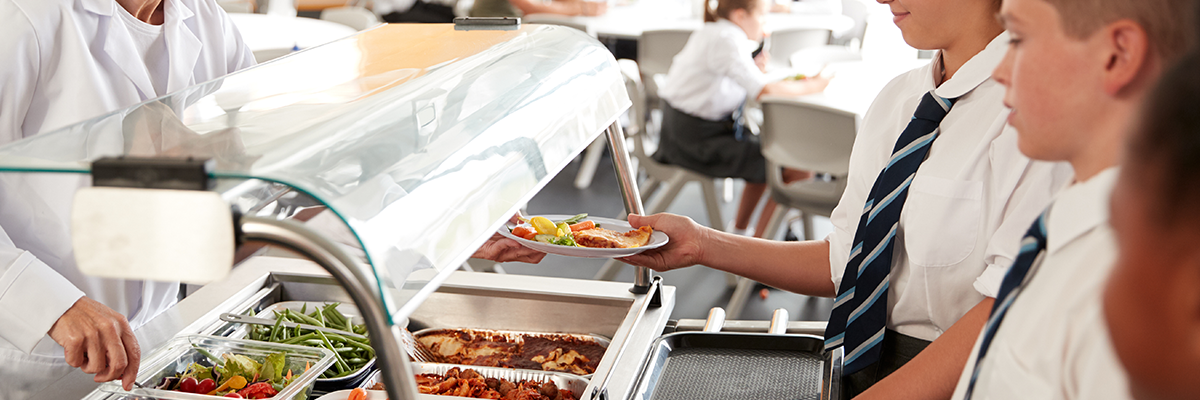Four Steps to Improve Your K-12 Foodservice Operation

If you run a foodservice operation, you understand it is inherently chaotic, from the daily deliveries, food preparation, never-ending piles of dishes, and customer service woes. At Envoy Solutions, we understand that a K-12 foodservice operation is all those challenges and more.
School foodservice operators are juggling the daily tasks of running the cafeteria and dealing with some of the trickiest customers: the kids! From food allergies to picky eaters, you must account for many different factors with children.
The stakes are high for school lunch programs with hundreds or thousands of little mouths to feed in just a few hours. Fortunately, there are a few ways to improve productivity in your K-12 foodservice operation, so you can keep students happy and healthy all year while improving your bottom line.
Identify Pain Points
The first step to improving your cafeteria is to identify any pain points. Fortunately, summer is the perfect time to get started. Set aside time to talk to your staff and assess your kitchen.
Ask your team the following questions:
- Does your team need help executing the weekly menu with the equipment currently in your kitchen?
- Does your food menu taste and look fresh?
- Are pieces of equipment breaking down?
- Do you need more space?
- Are there specific tasks that frustrate your staff?
- Where can you save time?
- Are you wasting food products or labor using inadequate equipment?
Work Smarter
Once you’ve identified your pain points, it’s time to start working smarter.
Technology, such as cook-chill systems, allows operators to produce a better food product in less time, with less waste.
The first part of a cook-chill system is a Combi Oven. Combi Ovens cook foods 25% faster than traditional convection ovens with multiple programmable cooking functions, including steaming, baking, air-frying, and grilling. In ‘combi mode’, the oven combines convection and steam technologies to produce enhanced color, flavor, and texture profiles. Pre-cooked frozen products, such as burgers and chicken breasts, will expand rather than shrink, enhancing the flavor and appearance.
The next part of a cook-chill system is a Blast Chiller/Freezer. Blast chillers allow hot products to be removed directly from the combi oven and put immediately in the refrigerator or freezer. The Blast Chiller allows for cooling in less than four hours, much faster than industry guidelines. The blast chillers remove the need to transfer product to the counter or walk-in box or to chill wands or paddles, extending the product's shelf life.
Finally, serve smarter with “action stations”, such as made-to-order deli bars, wokstations, or pizza stations. Look for stations that use ventless high-speed equipment that doesn’t need to go under a hood. That gives students the illusion and taste of freshly cooked food without using extra space in the kitchen or precious time for your staff. It will also give K-12 students a taste of what next-level education or collegiate dining will be like.
Simplify
One of the easiest ways to improve productivity for smaller school districts is to simplify your process by utilizing a commissary kitchen. You can save on labor and food costs by pre-cooking and preparing all the food at a central offsite location. When you condense the process by receiving all product at the same location, preparing it, and then distributing it to various schools for heating and serving, you can save on prep space and simplify logistics in each cafeteria.
Plus, when food is pre-cooked and chilled in a commissary kitchen, you’re cutting down on food waste because the product has a longer shelf life than food that is cooked and served in a traditional cafeteria.
Portable equipment such as serving carts, kiosks, and stations can attract business in locations such as busy hallways to help increase food sales.
Be Flexible
Make your foodservice equipment work for you. A morning coffee and pastry line could become a grab-and-go snack line in the afternoon. Use a rolling fruit cart at lunchtime to serve snacks at an afterschool event in the gym. If you add a mobile refrigerated unit, you could be serving ice cream outside from the same cart.
When you get creative with your equipment, you can save a lot of money and storage space in your cafeteria.
Are you looking to bring your school’s foodservice operation to the next level? Contact Envoy Solutions to schedule a consultation at your cafeteria. We specialize in helping you optimize your space and improve productivity in your kitchen.

